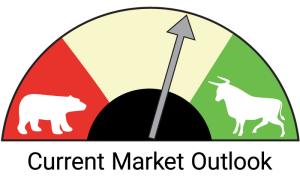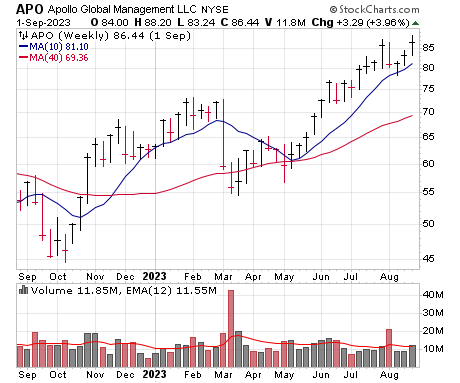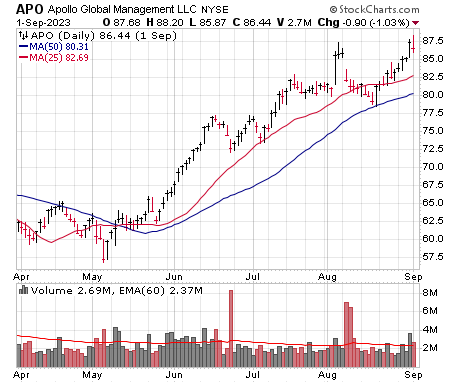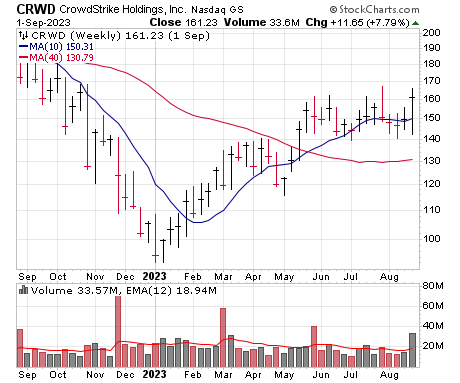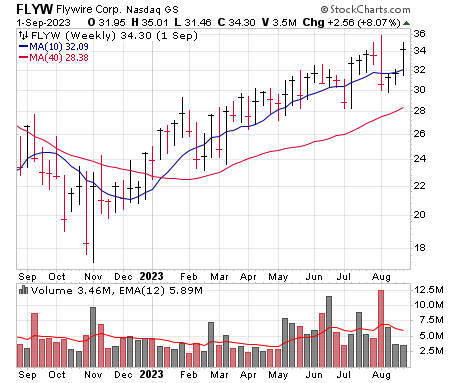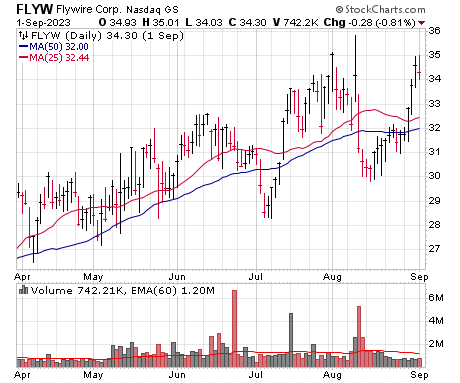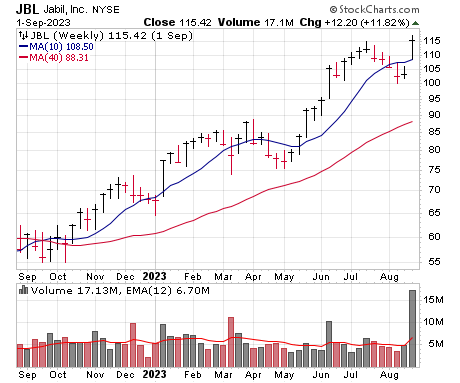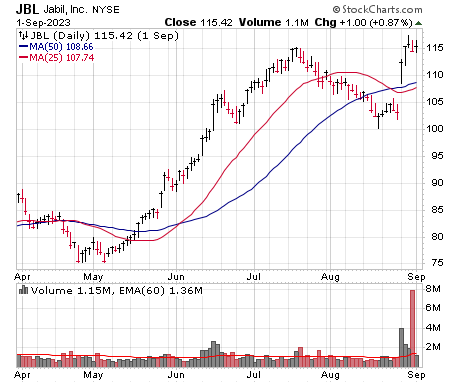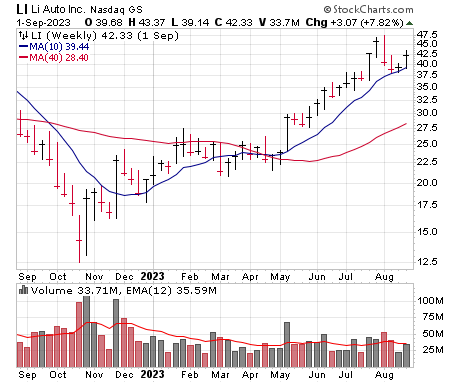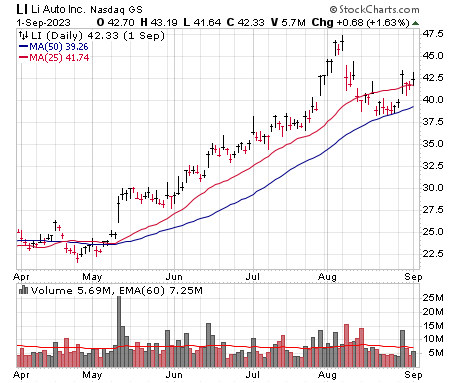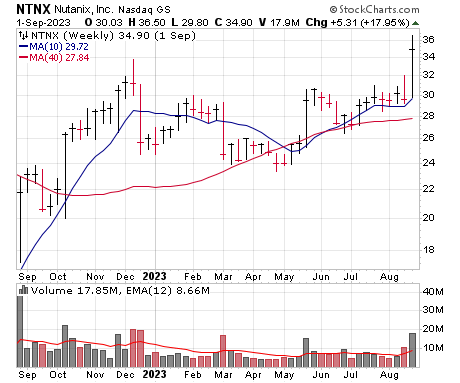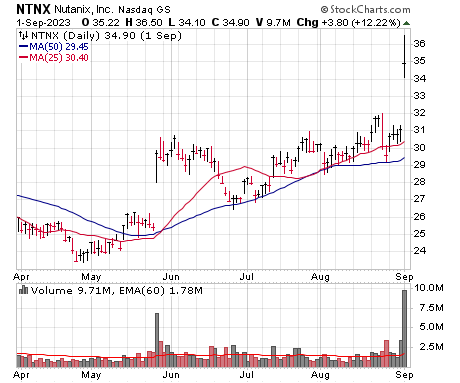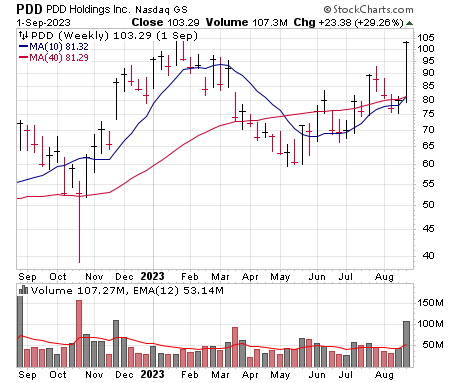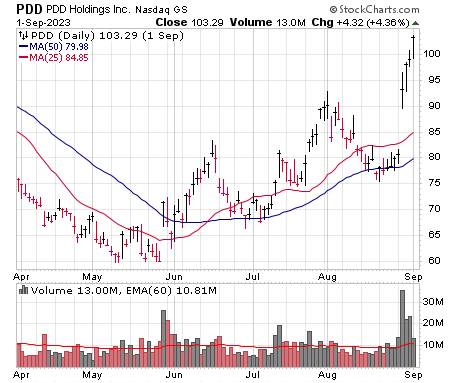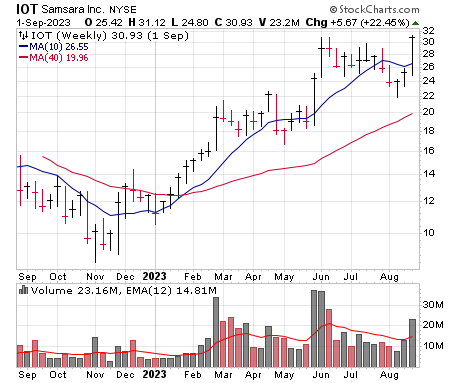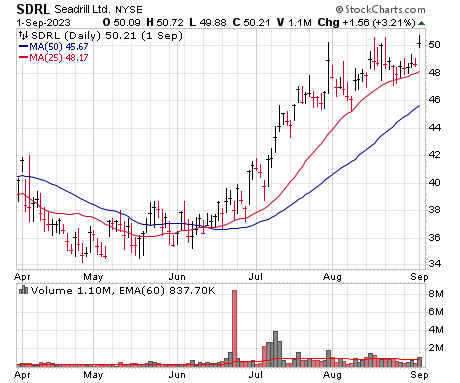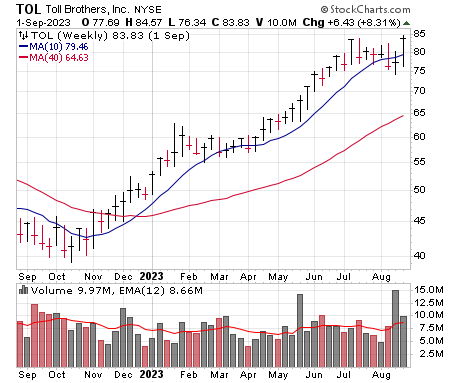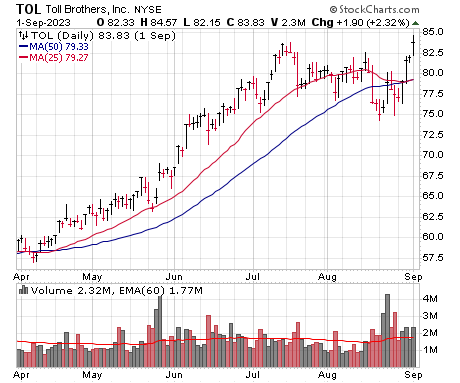Great First Few Steps—Now Looking for Follow Through
Following a tough 9% dip in the Nasdaq and 6% haircut in the S&P 500, the market rebounded about as well as the bulls could have hoped—all five indexes returned to (or just above) their 50-day lines prior to today, the broad market has taken a step forward, the Nasdaq has been outperforming (in fact, relative to defensive consumer staples, the Nasdaq hit a new high last week) and individual growth stocks have begun to pop higher, including many earnings winners last week. Now, with that said, we don’t advise cannon-balling back into the pool per se: The intermediate-term trend is mostly neutral here, interest rates are still a bugaboo and a lot of stocks still have work to do to repair the damage seen in late July and early August. Simply put, we see the past two weeks as a great first few steps for the market trying to emerge from its correction—but now we need to see continued follow through. We’ll bump our Market Monitor back to a level 6.
After a couple of so-so lists, this week’s crop of stocks is broad and includes many that have shown outsized buying volume of late. There are many enticing choices, but our Top Pick is Samsara (IOT), which is threatening to break free from its recent launching pad and a giant post-IPO base.
| Stock Name | Price |
| Apollo Global (APO) | |
| CrowdStrike (CRWD) | |
| Flywire (FLYW) | |
| Jabil (JBL) | |
| Li Auto (LI) | |
| Nutanix (NTNX) | |
| PDD Holdings (PDD) | |
| Samsara (IOT) ★ Top Pick ★ | |
| Seadrill (SDRL) | |
| Toll Brothers (TOL) |
Stock 1
Apollo Global (APO)
Price |
Why the Strength
Apollo (covered in the June 20 issue) is one of the world’s largest alternative asset managers with a specialization in credit, an area that accounts for nearly three-quarters of assets and should have plenty of upside as private credit takes share in the lending market; in recent years it has built a platform to serve the full spectrum of fixed-income needs of investors, from investment grade to leveraged lending. The fruits of those efforts were evidenced in the company’s Q2 numbers, which featured record quarterly fee-related earnings (FRE) of $442 million, or 74 cents per share, and record quarterly normalized spread-related earnings (SRE) of $874 million, or $1.47 per share, the latter of which come mainly from its recently acquired retirement divisions. Collectively, the two earnings streams totaled $1.3 billion, up 40% year-on-year, which the company said underscored “strong, resilient and fully aligned growth characteristics” of its asset management and retirement service segments. Total assets under management (AUM) of $617 billion rose 20% from the year before (and up 3% sequentially) and benefited from inflows of $43 billion in the quarter on an organic basis. Moving ahead, the company believes it’s on track to realize FRE and SRE of $5 billion combined for the full year, with the latter metric showing “exceptional strength” as Athene (Apollo’s life insurance affiliate) has grown SRE by 30% for two consecutive years and has already hit its 2026 financial target as laid out two years ago. What’s more, the firm’s fee-generating AUM is expected to continue growing at a torrid pace—in large part due to retirement service-related inflows. Big picture, Apollo is aiming for $1 trillion of assets by 2026 and $9.50-ish per share of FRE and SRE combined, and if asset valuations improve from here, even those figures could prove conservative. A 2% dividend yield is a cherry on top of this bull market story.
Technical Analysis
APO was hit hard in the bear market as would be expected, and after rallying back some, took another dip during the March banking crisis. But the stock changed character in mid-May and had a persistent advance all the way to new all-time highs in July. There was some shaking and baking after that (partly due to a convertible offering), but APO held the 50-day line and has rallied back to its highs. We’re OK nibbling on minor weakness.
| Market Cap | $49.0B | EPS $ Annual (Dec) | ||
| Forward P/E | 13 | FY 2021 | 7.32 | |
| Current P/E | 40 | FY 2022 | 5.21 | |
| Annual Revenue | $26.8B | FY 2023e | 0.08 | |
| Profit Margin | 4.4% | FY 2024e | 8.13 | |
| Qtrly Rev | Qtrly Rev Growth | Qtrly EPS | Qtrly EPS Growth | |
| ($B) | (vs. yr-ago-qtr) | ($) | (vs. yr-ago-qtr) | |
| Latest qtr | 13.70 | 499% | 1.00 | N/A |
| One qtr ago | 5.30 | 515% | 1.66 | N/A |
| Two qtrs ago | 4.84 | 305% | 1.06 | 16% |
| Three qtrs ago | 2.98 | 176% | -1.52 | N/A |
Weekly Chart | Daily Chart |
Stock 2
CrowdStrike (CRWD)
Price |
Why the Strength
There’s no question cybersecurity remains in a long-term growth phase, with the mobile and work-from-home reality, as well as AI (which will be used by defenders and hackers to advance their efforts), increasing the need for it. CrowdStrike has been one of the leaders in the space for a long time, with a platform that started with endpoint security years ago (protecting an employee’s cell phone, tablet or laptop—and then integrating the trillions of data points per week into the platform, becoming “smarter” over time) but has branched out into many new categories in recent years—such as extended detection and response, log protection, automated malware search and analysis, identity protection, IT and file security, observability and more—a bunch of which are growing like mad (log users up three-fold year-on-year; identity protection revenue growing at more than 100%); all in all, the cloud-native platform stops breaches, saves time and allows big firms to get an all-in-one solution instead of buying sometimes dozens of different patches. And, business-wise, not only is CrowdStrike still growing rapidly at scale, but it’s doing so in an increasingly profitable way: In Q2, revenues and annualized recurring revenue (ARR) lifted 37%, but earnings more than doubled and free cash flow for the first half of the year came in north of $1.70 per share, and management said it’ll reach its target model for operating and free cash flow margins (north of 30% of revenue!) by year end. (Free cash flow is expected to rise to nearly $3.75 per share this fiscal year.) Growth is slowing a bit due to the firm’s size (nearly $3 billion in ARR), but analysts see revenues up 28% next year, so it’s certainly not slowing down much from here. It’s a great story that should continue to play out for years to come.
Technical Analysis
CRWD topped near 300 in 2021, fell to 92 by January of this year and then rebounded decently into the 160 area in May. It stalled out at that point, but it never really got hit—shares essentially moved sideways between 140 and 165 (give or take), and recently, there was some tightness on the weekly chart in the 145 to 150 area. Last week’s earnings move took CRWD back to the top of its structure; we think you can start a position around here and look to add should the stock (and market) perk up. Note that peer Zscaler (ZS) reports earnings tonight, which could cause some near-term movement, but the CRWD’s overall pattern looks sound.
| Market Cap | $39.0B | EPS $ Annual (Jan) | ||
| Forward P/E | 58 | FY 2022 | 0.67 | |
| Current P/E | 75 | FY 2023 | 1.54 | |
| Annual Revenue | $2.64B | FY 2024e | 2.79 | |
| Profit Margin | 24.6% | FY 2025e | 3.46 | |
| Qtrly Rev | Qtrly Rev Growth | Qtrly EPS | Qtrly EPS Growth | |
| ($M) | (vs. yr-ago-qtr) | ($) | (vs. yr-ago-qtr) | |
| Latest qtr | 732 | 37% | 0.74 | 106% |
| One qtr ago | 693 | 42% | 0.57 | 84% |
| Two qtrs ago | 637 | 48% | 0.47 | 57% |
| Three qtrs ago | 581 | 53% | 0.40 | 135% |
Weekly Chart | Daily Chart |
Stock 3
Flywire (FLYW)
Price |
Why the Strength
Flywire is a payments processor that specializes in complex, cross-border payments for the education, travel, healthcare and business-to-business markets. The company is able to offer simpler transactions for payments partners in one country, such as China’s WeChat Pay, through its partnerships and tie-ins with institutions in other countries, such as with the State Bank of India. The rise in international students, health care tourism and foreign travel all bolster Flywire’s value proposition to clients. While Flywire’s core offering has been cross-currency dealings, it’s making big strides to become a vendor of choice for purely domestic transactions, recently inking a deal with Canada’s Interac, a network of real-time payment solutions, which the firm expects will enable it to capture more domestic education payments. In addition to payments processing, it also offers technologies to improve bill collection; one client, Wellesley College in Massachusetts, saw its overdue tuition bills drop 20% after switching to Flywire’s collections system. As collections shows, Flywire believes its deep technological expertise in its four sectors gives it a competitive edge in those markets. For example, in health care, it sells various automated self-pay services for website and phone calls, with its systems now handling 95% of online payments for one large health network. All told, Flywire is small, but business is good: In Q2, reported last month, revenue less ancillary services grew 57% on a currency-neutral basis, total payment volume was up 43% and, while the bottom line is still in the red, EBITDA clocked in at breakeven. Growth is expected to slow but 25% to 30% top-line growth is likely for many quarters to come.
Technical Analysis
Nearly two and a half years since its IPO at 24 and the ups (to 57) and downs (to 15) that followed, FLYW has established a steady uptrend, advancing in a two-steps-forward, one-step-back pattern in recent months. Shares hit a 20-month high of 35 at the start of August but slipped after a post-earnings share offering brought in some selling. But the decline wasn’t out of character for FLYW, and sure enough, shares have returned to their highs. The recent mini-dip can be used to start a position with a stop in the low 30s
| Market Cap | $4.20B | EPS $ Annual (Dec) | ||
| Forward P/E | N/A | FY 2021 | -0.27 | |
| Current P/E | N/A | FY 2022 | -0.36 | |
| Annual Revenue | $348M | FY 2023e | -0.17 | |
| Profit Margin | N/A | FY 2024e | 0.00 | |
| Qtrly Rev | Qtrly Rev Growth | Qtrly EPS | Qtrly EPS Growth | |
| ($M) | (vs. yr-ago-qtr) | ($) | (vs. yr-ago-qtr) | |
| Latest qtr | 84.9 | 50% | -0.15 | N/A |
| One qtr ago | 94.4 | 46% | -0.03 | N/A |
| Two qtrs ago | 73.1 | 42% | -0.01 | N/A |
| Three qtrs ago | 95.2 | 40% | -0.04 | N/A |
Weekly Chart | Daily Chart |
Stock 4
Jabil (JBL)
Price |
Why the Strength
For years, contract electronics manufacturer Jabil has made the metal casings and components used for Apple’s iPhones, iPads, AirPods and other popular products. At one point, the electronics giant was Jabil’s biggest customer, accounting for upwards of 30% of its annual sales (though it was down to “only” 19% last year). While lucrative, the Apple-related business was also low-margin, and with global smartphone sales having been in a slump for the last eight quarters, Jabil has made a strategic decision to decrease its reliance on Apple while increasing its exposure to industries with far greater growth potential. To that end, Jabil just announced that Chinese EV maker BYD Electronic has agreed to buy its mobility-related production arm in China—which includes the Apple components business—for $2.2 billion (the reason for the stock’s latest strength). If and when completed, the deal will be the largest in Jabil’s history and allow the company to allocate more capital to share buybacks (the share count was down a big 5.7% from a year ago in May’s quarter) while providing “opportunities for further investment in [EVs], renewable energy, healthcare, AI cloud data centers and other end-markets.” In fiscal Q3 (ended May 31), revenue of $8.5 billion rose 2% from a year ago, led by Diversified Manufacturing Services sales growth of 13%, while EPS of $1.99 topped estimates by 12 cents. Wall Street likes what it sees here and expects 10%-ish bottom-line growth in each of the next three years, which could prove conservative given the company’s growing exposure to higher-margin industries and the likelihood of accelerating share repurchases that could goose the bottom line. It’s a simple, straightforward story that should have legs. Earnings are due September 26.
Technical Analysis
JBL actually broke out to new highs in January of this year, well ahead of most stocks, and it’s had two meaningful pullbacks since then—the first in April (five weeks long, 15% deep), and after a strong move to 115 in July, another one recently (four weeks long, 13% deep). But the BYD sale announcement brought the buyers back in last week, with the stock showing two very big-volume buying days after that as JBL tested its old highs. We’ll set our buy range down a bit, thinking more of an exhale could be on the way.
| Market Cap | $15.2B | EPS $ Annual (Aug) | ||
| Forward P/E | 16 | FY 2021 | 5.61 | |
| Current P/E | 13 | FY 2022 | 7.65 | |
| Annual Revenue | $35.3B | FY 2023e | 8.51 | |
| Profit Margin | 3.2% | FY 2024e | 9.30 | |
| Qtrly Rev | Qtrly Rev Growth | Qtrly EPS | Qtrly EPS Growth | |
| ($B) | (vs. yr-ago-qtr) | ($) | (vs. yr-ago-qtr) | |
| Latest qtr | 8.48 | 2% | 1.99 | 16% |
| One qtr ago | 8.13 | 8% | 1.88 | 12% |
| Two qtrs ago | 9.64 | 12% | 2.31 | 20% |
| Three qtrs ago | 9.03 | 22% | 2.34 | 63% |
Weekly Chart | Daily Chart |
Stock 5
Li Auto (LI)
Price |
Why the Strength
Li Auto is a Chinese outfit that makes extended-range electric vehicles (EREV) for sale in its home country; these are primarily EVs that have a small gasoline engine that kicks in to provide extended mileage—for its Li 9, a six-passenger family SUV that’s the firm’s third model to hit the market, that engine can provide up to 800 miles of range. Li’s emphasis on extended range appeals to drivers with range anxiety when dealing with pure EVs, and it’s clearly tapped into something. The automaker has been quick-growing and generally able to hit its targets: It took about 39 months for the company to sell its first 300,000 units after debuting in December 2019 but just four months to deliver another 100,000 vehicles, breaking the 400,000 mark in July. Those deliveries helped Li post second-quarter revenue of 28.7 billion renminbi (or USD$3.95 billion), while also seeing a rise in the average selling price and expansion of gross margins, something that had been crimped earlier this year by a ramp up in production. That also allowed earnings to continue their advance, up to 36 cents in the quarter, from 20 cents and 13 cents the prior two. Deliveries of nearly 90,000 cars in the quarter beat projections by about 10%, and the top brass sees a bit over 100,000 sold in Q3 (the first two months brought 69,000 unit sales so that could prove a bit conservative). All in all, Li remains in a good position in China, with about 2% market share of all car sales from its three EREV models, the Li 6, 7 and 9. This quarter, sales should rise about 250% over 2022’s Q3, to around RMB 32.8, or $4.5 billion. Eventually, battery EVs (BEVs) are expected to dominate the market, and Li will be a player there—it debuted its first plug-in EV this summer, the Mega, which will be in company-owned showrooms by the end of the year. To support its BEV plans, Li is building a supercharging network through China, aiming to have 5,000 in place in two years, and the firm is thinking big, with a goal of challenging Mercedes, Audi and BMW for the title of best-selling luxury marque in China.
Technical Analysis
After an off-the-bottom rally starting last October, LI broke out from a proper launching pad in early May and ran nicely higher, testing its all-time highs from late 2020 near 48. But some sell-the-news action after the Q2 report (sequential sales growth was a bit lower than hoped) sapped momentum, leading to a well-deserved pullback. LI’s dip found support near the 50-day line, though it’s been gyrating up and down in recent days. We’ll put our buy range up from here, thinking a strong snapback would increase the odds of a resumption of the overall uptrend.
| Market Cap | $41.0B | EPS $ Annual (Dec) | ||
| Forward P/E | 54 | FY 2021 | 0.13 | |
| Current P/E | 82 | FY 2022 | 0.01 | |
| Annual Revenue | $10.6B | FY 2023e | 0.79 | |
| Profit Margin | 9.5% | FY 2024e | 1.37 | |
| Qtrly Rev | Qtrly Rev Growth | Qtrly EPS | Qtrly EPS Growth | |
| ($B) | (vs. yr-ago-qtr) | ($) | (vs. yr-ago-qtr) | |
| Latest qtr | 3.95 | 203% | 0.36 | N/A |
| One qtr ago | 2.74 | 81% | 0.20 | 165% |
| Two qtrs ago | 2.56 | 53% | 0.13 | 26% |
| Three qtrs ago | 1.31 | 9% | -0.18 | N/A |
Weekly Chart | Daily Chart |
Stock 6
Nutanix (NTNX)
Price |
Why the Strength
Enterprise cloud platform provider Nutanix offers a unified system that combines networking and data storage into a single platform that allows customers to easily move different apps between clouds. This so-called “hyperconverged infrastructure” makes it possible to build data centers on a massive scale, with a smaller footprint and to expand more easily. Last week, Nutanix’s stock exploded higher after the company released results for fiscal Q4 (ended July 31) which showed healthy year-over-year top-line growth and sharp improvements in profitability and free cash flow—improvements the company attributes to its transition from continually selling hardware appliances to a subscription model where its wares are always up to date for a monthly or quarterly fee. Revenue of $494 million jumped a very solid 28% in Q4 (big acceleration from prior quarters), earnings of 24 cents a share beat estimates by eight cents and the company delivered its first ever full fiscal year of profitability. Nutanix said the progress it has made with the subscription model was demonstrated specifically in annual contract value (ACV, a key metric) billings growth of 44%, with outperformance in the renewals business reflected in annual recurring revenue (ARR) climbing 30% in Q4. Moreover, free cash flow (FCF) nearly doubled in the quarter, to $46 million, while full-year FCF of $200 million was more than twice the firm’s prior guidance and was well ahead of earnings. The top brass expressed confidence in Nutanix’s long-term prospects, authorizing a share repurchase of up to $350 million (around 5% of total shares outstanding), while guiding for fiscal 2024 revenue of around $2.1 billion at the midpoint (up 13% if realized). Meanwhile, Wall Street sees the bottom line growing substantially in the next two years, with free cash flow following suit.
Technical Analysis
NTNX jumped on earnings last December and tagged a multi-month high at 34 before hitting a snag. It went south immediately after that and drifted lower until bottoming at 23 in late April, with shares catching a break around the 40-week line. Shares reacted well to earnings in May and then etched a very tight launching pad, with last Friday’s earnings gap bringing the breakout. If you’re game, we advise aiming for dips.
| Market Cap | $8.40B | EPS $ Annual (Jul) | ||
| Forward P/E | 45 | FY 2022 | -0.47 | |
| Current P/E | 45 | FY 2023 | 0.60 | |
| Annual Revenue | $1.86B | FY 2024e | 0.80 | |
| Profit Margin | 13.7% | FY 2025e | 0.90 | |
| Qtrly Rev | Qtrly Rev Growth | Qtrly EPS | Qtrly EPS Growth | |
| ($M) | (vs. yr-ago-qtr) | ($) | (vs. yr-ago-qtr) | |
| Latest qtr | 494 | 28% | 0.24 | N/A |
| One qtr ago | 449 | 11% | 0.15 | N/A |
| Two qtrs ago | 487 | 18% | 0.15 | N/A |
| Three qtrs ago | 434 | 15% | 0.15 | N/A |
Weekly Chart | Daily Chart |
Stock 7
PDD Holdings (PDD)
Price |
Why the Strength
Despite a sluggish economy, consumer sentiment in China’s post-lockdown economy has become increasingly cheerful lately, fueling a rise in demand across multiple product categories for online sales, according to PDD Holdings (formerly Pinduoduo). The Chinese e-commerce leader, which combines online shopping with social media to offer deep discounts to group shoppers of household, food and apparel items, just released earnings that obliterated consensus expectations (the reason for the stock’s strength). The company’s Q2 results benefited from aggressive sales promotions during June’s “618” shopping festival—China’s second-largest shopping festival of the year. Also contributing to the strength was PDD’s continued investments in agricultural projects that bring customers better-quality food options while helping farmers boost their incomes. On this score, PDD emphasizes high-tech solutions, including advanced precision farming, along with 40 “cutting-edge” systems that help farmers boost crop yields by up to 30% while reducing costs. The end result of these efforts is increasing modernization for China’s ag sector, as well as “optimization” in the matching of supply and demand for both growers and customers. The ongoing focus on agriculture and ag digitization was a big contributor to PDD’s total Q2 revenue of $7.2 billion, which mushroomed 66% year-on-year (in local currency terms), plus earnings of $1.44 a share that topped estimates by a whopping 63 cents. The company also reported progress in growing its cross-border marketplace, Temu, which connects Chinese merchants to foreign customers. Analysts see sales up 51% this year and another 25% in 2024, while earnings kite higher as well. It’s a solid long-term growth story that continues to impress.
Technical Analysis
After a solid but very jagged rally, PDD topped in January and tumbled into May along with many of its Chinese peers. Shares dipped 44% before finding solid support at 60 and beginning to repair the damage, with a couple of thrusts higher followed by pullbacks. But last week’s earnings was the big event, with not just a solid reaction but three days of good-volume buying after that. There is some resistance up here, so we’ll set our buy range down a bit, though we’re not expecting a huge dip.
| Market Cap | $151B | EPS $ Annual (Dec) | ||
| Forward P/E | 22 | FY 2021 | 1.48 | |
| Current P/E | 20 | FY 2022 | 3.98 | |
| Annual Revenue | $23.5B | FY 2023e | 4.71 | |
| Profit Margin | 29.2% | FY 2024e | 5.82 | |
| Qtrly Rev | Qtrly Rev Growth | Qtrly EPS | Qtrly EPS Growth | |
| ($B) | (vs. yr-ago-qtr) | ($) | (vs. yr-ago-qtr) | |
| Latest qtr | 7.21 | 54% | 1.44 | 28% |
| One qtr ago | 5.48 | 46% | 1.01 | 117% |
| Two qtrs ago | 5.77 | 35% | 1.21 | 31% |
| Three qtrs ago | 4.99 | 50% | 1.21 | 258% |
Weekly Chart | Daily Chart |
Stock 8
Samsara (IOT) ★ Top Pick ★
Price |
Why the Strength
Samsara is the leading cloud provider for firms with lots of physical assets, offering them a plug-and-play option (no need for professional installation) for telematics, video-based safety (better tracking of assets, fewer driving accidents, eventually lower insurance costs, etc.) and equipment monitoring (quickly locating and repositioning assets), with more offerings (like connected forms, allowing the digitization of standard forms like incident reports or inspections) coming by year’s end. Yes, big transport firms are clients, but the opportunity is much broader than that, with construction, utilities, energy, agriculture and even airlines (ground support equipment at airports) signing up, with a whopping 84% of net new business in Q2 coming from non-transport areas. And they’re signing up because Samsara provides a very quick (within months) return on investment, which is key for people in charge of operations budgets, which the firm sells into. The market size here is in the tens of billions of dollars, and big investors are seeing the writing on the wall that Samsara is going to get much, much bigger in time. In Q2, revenues grew 43%, annualized recurring revenue (ARR) was up 40% and net new ARR (which is split evenly between current clients expanding their purchases and new client sign-ups) is actually showing accelerating growth (up 33% in Q2), all while free cash flow turned positive in the quarter for the first time. (Samsara gets paid based on how many pieces of equipment are tied to its cloud offerings, so it’s not subject to employee turnover or layoffs.) Management made it clear they’re after the big players (half of its ARR comes from clients that pay over $100k a year, a figure that’s up 53% from a year ago), so the upside is huge as they expand their purchases. To be fair, the valuation is up there, but Samsara smells like an emerging blue chip.
Technical Analysis
IOT flashed a rare sign of power (we call it Double Skyscrapers, with two massive-volume buying weeks and big gains) after earnings in early June, but shares quickly gave up most of their gain, and when the market turned weak, the stock dipped to 22 (29% off its highs). But the action of the past two weeks has been pristine, with a straight-up advance and a boom after earnings last Friday that took the stock back to its June highs. We wouldn’t argue with a nibble here, though dips of a point or two would be better.
| Market Cap | $16.0B | EPS $ Annual (Jan) | ||
| Forward P/E | N/A | FY 2022 | -0.23 | |
| Current P/E | N/A | FY 2023 | -0.13 | |
| Annual Revenue | $780M | FY 2024e | 0.01 | |
| Profit Margin | 1.8% | FY 2025e | 0.04 | |
| Qtrly Rev | Qtrly Rev Growth | Qtrly EPS | Qtrly EPS Growth | |
| ($M) | (vs. yr-ago-qtr) | ($) | (vs. yr-ago-qtr) | |
| Latest qtr | 219 | 43% | 0.01 | N/A |
| One qtr ago | 204 | 43% | -0.02 | N/A |
| Two qtrs ago | 187 | 48% | -0.02 | N/A |
| Three qtrs ago | 170 | 49% | -0.02 | N/A |
Weekly Chart | Daily Chart |
Stock 9
Seadrill (SDRL)
Price |
Why the Strength
Most people are talking about the economy, the Fed, interest rates or even things like AI, but oil has been an underappreciated story this year, with black gold lifting to multi-month highs above $87 today. We’ve written before about the early-stage boom in offshore drilling, so we won’t rehash all of that here; suffice it to say that a horrid dry spell in the industry has led to a big cut in on-the-water capacity, and yet many oil majors and countries are looking to secure long-term oil supplies, with deepwater areas often providing outstanding well economics. Seadrill was one of the hottest drillers eight years ago, but then went belly up in 2020; it tightened its belt (very reasonable net debt position) and came public again last October, and after a modest acquisition and some reshuffling (selling off some non-core rigs), the firm now has 18 active rigs (including 12 contracted deepwater rigs; there are also 3 rigs still cold-stacked) that are among the youngest out there. And with the environment improving rapidly, the backlog stands at $2.4 billion as of mid-August (miles above the last 12 months of revenue), with three rigs coming off contract by early next year that should be signed up with much higher dayrate deals. Management has guided for EBITDA of around $460 million this year, and that figure should only rise as the market remains tight and new deals are inked. A fresh $250 million share buyback program should help the cause as well. After going through the wringer, Seadrill looks like a fresh winner in the oil patch.
Technical Analysis
SDRL was re-listed last fall near the market bottom, so it’s not a total surprise shares acted well out of the gate, running from the mid-20s to the mid-40s by January of this year. Then came a nice, smooth cup-shaped base for four months, and once we got into July, the buyers pounced—SDRL saw an excellent volume cluster early that month, and shares have continued to act well since then, riding the 25-day line higher since then. The 50 area has been round number resistance, so we’ll set our buy range down a bit, aiming to get on dips.
| Market Cap | $4.07B | EPS $ Annual (Dec) | ||
| Forward P/E | 15 | FY 2021 | -5.70 | |
| Current P/E | 38 | FY 2022 | N/M | |
| Annual Revenue | $1.18B | FY 2023e | 3.39 | |
| Profit Margin | 22.7% | FY 2024e | 4.40 | |
| Qtrly Rev | Qtrly Rev Growth | Qtrly EPS | Qtrly EPS Growth | |
| ($M) | (vs. yr-ago-qtr) | ($) | (vs. yr-ago-qtr) | |
| Latest qtr | 414 | 64% | 1.16 | N/A |
| One qtr ago | 266 | 2% | 0.83 | N/A |
| Two qtrs ago | 228 | -17% | -0.36 | N/A |
| Three qtrs ago | 269 | 21% | -0.36 | N/A |
Weekly Chart | Daily Chart |
Stock 10
Toll Brothers (TOL)
Price |
Why the Strength
Housing starts in the U.S. haven’t kept pace with demand, resulting in a substantial shortfall in housing availability and pushing more prospective homeowners toward building a new house, providing the perfect backdrop for Toll Brothers. The company designs, builds and sells mostly residential properties in the U.S., with a leading position in luxury homes and apartments in upscale communities. Despite rising mortgage rates, Toll Brothers enjoys a significant backlog (nearly $8 billion!) of around 7,300 homes, and cancellations remain “very low.” Higher rates are serving as a deterrent for existing homeowners to sell their houses, thereby keeping the supply of available homes low and prices elevated, and this firm’s customer base is less interest rate sensitive anyway—on a long-term basis, 20% of Toll’s buyers pay all-cash when purchasing their home (!), and that figure has been higher recently, at 23% in Q2 and 25% in the recently reported Q3. Additional secular trends pushing housing demand include Millennials entering the home market and the work-from-home boom, both of which provide buyers with more options for choosing locations. These factors and others combined to help Toll Brothers take in nearly $3 billion in revenue during fiscal Q3 (ended July 31)—an 8% improvement from a year ago—while driving an eye-opening 30% earnings beat of $3.76 a share. During the quarter, the firm signed 2,245 net contracts for over $2 billion, which was actually up 30% in dollars compared to last year’s Q3 when interest rates were much lower. On a per-community basis, Toll Brothers sold at a pace of 2.2 homes per month, up 70%. Interest rates remain the big fear here, as they could crush demand eventually, but the top brass raised guidance and analysts see earnings rising to $12 per share for the year and remaining at that level in 2024.
Technical Analysis
TOL fell from a 2021 high of 75 to a low near 40 in June and October of last year, as investors assumed higher mortgage rates would hurt results. But as mortgage rates leveled out and earnings growth continued, the stock rallied smartly, first to 63 near the end of January and, after a tight two-month base, to 84 in mid-July. TOL did come in with the market this summer, but the damage was limited and the stock poked back to new highs on Friday, though today’s drop was a bit iffy. We’ll set our buy range above today’s range; if it can shrug off today’s it should lead to a sustained move.
| Market Cap | $9.18B | EPS $ Annual (Oct) | ||
| Forward P/E | 7 | FY 2021 | 6.63 | |
| Current P/E | 6 | FY 2022 | 10.90 | |
| Annual Revenue | $10.7B | FY 2023e | 12.05 | |
| Profit Margin | 15.4% | FY 2024e | 11.82 | |
| Qtrly Rev | Qtrly Rev Growth | Qtrly EPS | Qtrly EPS Growth | |
| ($B) | (vs. yr-ago-qtr) | ($) | (vs. yr-ago-qtr) | |
| Latest qtr | 2.69 | 8% | 3.73 | 59% |
| One qtr ago | 2.51 | 10% | 2.85 | 54% |
| Two qtrs ago | 1.78 | -1% | 1.70 | 37% |
| Three qtrs ago | 3.71 | 22% | 5.63 | 86% |
Weekly Chart | Daily Chart |
Previously Recommended Stocks
| Date | Stock | Symbol | Top Pick | Original Buy Range | 9/5/23 |
| HOLD | |||||
| 8/14/23 | 510-525 | 565 | |||
| 6/20/23 | 74-76.5 | 89 | |||
| 7/24/23 | 505-520 | 514 | |||
| 8/21/23 | ★ | 178-185 | 197 | ||
| 7/3/23 | ★ | 43-44.5 | 45 | ||
| 8/21/23 | 34-35.5 | 37 | |||
| 8/7/23 | ★ | 93-96.5 | 89 | ||
| 8/21/23 | 27.5-29.5 | 30 | |||
| 8/14/23 | 55-56.5 | 56 | |||
| 5/15/23 | ★ | 123-128 | 197 | ||
| 7/24/23 | 33-34.5 | 37 | |||
| 7/17/23 | 155-161 | 180 | |||
| 7/17/23 | 18.7-19.1 | 24 | |||
| 8/14/23 | ★ | 77.5-80 | 76 | ||
| 8/7/23 | 19.5-20.5 | 22 | |||
| 8/14/23 | 265-273 | 262 | |||
| 8/7/23 | 134-138 | 147 | |||
| 8/14/23 | 54-56 | 59 | |||
| 8/21/23 | 51-53 | 57 | |||
| 7/10/23 | ★ | 45-47 | 53 | ||
| 8/28/23 | Northern Oil & Gas | NOG | 39.5-41 | 42 | |
| 2/27/23 | 225-230 | 485 | |||
| 8/28/23 | Palo Alto Networks | PANW | 241-245 | 245 | |
| 8/7/23 | 36.5-38 | 40 | |||
| 7/31/23 | ★ | 83-86 | 79 | ||
| 5/8/23 | 37-39 | 47 | |||
| 8/7/23 | Zillow | Z | 53.5-55 | 52 | |
| WAIT | |||||
| 8/28/23 | 100-102.5 | 105 | |||
| 8/28/23 | 148-153 | 156 | |||
| 8/28/23 | 73-75 | 76 | |||
| 8/28/23 | 58-60 | 51 | |||
| 8/28/23 | ★ | 112.5-115.5 | 124 | ||
| 8/28/23 | Yeti | YETI | 44.5-46 | 50 | |
| SELL | |||||
| 7/24/23 | 28-29.5 | 28 | |||
| 7/31/23 | 393-408 | 423 | |||
| 8/14/23 | 44-45.5 | 45 | |||
| 7/17/23 | 56.5-58 | 68 | |||
| 8/7/23 | TopBuild | BLD | 280-290 | 280 | |
| DROPPED | |||||
| 8/21/23 | 183-188 | 214 | |||
| 8/21/23 | 34-36 | 43 | |||
| 8/21/23 | 76.5-78.5 | 84 | |||
| 8/21/23 | 80.5-82.5 | 85 | |||
| 8/21/23 | 32-34 | 39 | |||
The next Cabot Top Ten Trader issue will be published on September 11, 2023.

